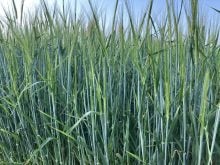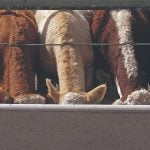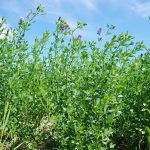Holdanca Farms emphasizes importance of wildlife, rotational grazing and sustainable farming
The Canadian Beef Industry Conference is the biggest of the year, and one of the biggest awards gets announced here too.
The lights in the conference centre are dimmed and the hall buzzes with conversation and the clinking of cutlery, but also with excitement as The Environmental Stewardship Award (TESA) announcement draws closer.
The crowd jumps to their feet at the announcement of this year’s winner, Holdanca Farms of Nova Scotia, run by father-daughter duo John and Maria Duynisveld.
Read Also

Canadian Beef Check-Off Agency reports on investments and activities
The check-off agency’s work behind the scenes is what ensures cattle check-off dollars are invested wisely, accounted for transparently and deliver measurable value back to producers and importers.
They were chosen for the national award from among the winners of provincial awards that recognize the work of producers using sustainable and regenerative practices to enhance the environment.
“Holdanca Farms is a testament to how responsible farming practices can go hand in hand with success and their importance to protecting and preserving our land and wildlife,” Mike Duguid, one of the co-chairs of CCA’s environment committee, says in a press release.
Holdanca Farms is near Wallace Bay on Nova Scotia’s North Shore, near the Northumberland Strait and the Wallace River. The North Shore is usually known for its warm water, beaches and fresh lobster, but in this case, it makes a great location for a flourishing farm.

The Duynisvelds manage 500 acres, half of which is a native woodlot and the other half pasture. They raise beef cattle alongside sheep, pigs and chickens, and offer custom grazing services.
In an interview after the ceremony, Maria says she’s been interested in agriculture since she was a child growing up on the farm, and as a toddler known for standing on a bucket to help process the chickens.
Now she has a degree in agriculture, plus interests in conservation, agroecology and biodiversity. She says the farm is the perfect place to pursue them.
Wet soil and hurricanes
John says winters are mild, which makes it easier to grow good grass, starting in early May and continuing well into November.
However, there are challenges.
“On the challenging side our soils don’t have great drainage. When it is wet we have mud. When it is dry, the soil is very hard. We cope with this by adapting our grazing management to get the conditions we are experiencing. Over the years our soil organic matter has increased and this helps deal with the wet and dry spells.”
They also have to deal with hurricanes. In the past they’ve averaged one every three years, but Maria says they have been increasing in frequency.
However, there are many benefits to the location. The Duynisvelds direct-market most of their meat to Halifax weekly. Because their farm is small and they don’t have much opportunity to expand, this helps them become more viable.
“We’re part of a co-operative market that’s open four days a week, so we’re one of the starting partners with that,” John says. “It’s open Wednesday to Saturday, so either Tuesday evening or Wednesday morning, we have to get everything all delivered down there.”
Sustainable practices
One of Holdanca Farms’ priorities is implementing sustainable practices.
John says rotational grazing is a tried-and-true practice on their operation, since even before his time. His father started it in 1988, so he has seen the benefits first-hand.
“The field that we’re sitting in right now, where we’re just doing a couple of repairs before we move the cows into this paddock, is the one that he started doing rotational grazing on, and it is, to this day, our most productive field on the farm,” John says.
Many migratory birds pass through the area. John and Maria have documented over 1,000 different species on their land, more than 30 of which are endangered or threatened.
“The birds don’t realize that the Wildlife Area stops where our land begins. We’re a key stopping point for birds that are migrating. So we get to see a lot of these interesting species,” Maria says.
They work to ensure a viable habitat for all of the animals on their property. John says not only is it fun to have them on their property, but the birds eat a lot of bugs, which is a win/win.
John says they modify their grazing strategies by grazing some fields in May and letting them rest until mid-July so they can be used by the migratory birds.
“It lets bobolinks, willets and sparrows have a chance to build their nests and fledge their young before we come back to graze. We use a higher level of grazing management after this rest, often moving them three times a day to effectively use the high quantity of grass that is present.”
The Duynisvelds also incorporate some intercropping and try to extend their grazing season as much as possible. John says last year they got to graze into February because of the perennials they had grown for winter grazing. They have also been bale grazing for over 20 years.
Maria emphasizes the benefits of intercropping. They have grown crops such as corn and turnips together, which have been hits with their livestock.
“In polyculture, we’re not creating a monoculture, like an ecological dead zone that way. So we’ve done, actually, some very diverse polycultures.”
The Duynisvelds also manage their native woodlot alongside their local co-op. They say a diversity of plant life in the forest is beneficial because it supports soil and animals and becomes more diverse and therefore more resilient to challenges.
Holdanca Farms is involved in agriculture education programs such as Ag in the Classroom, as well as environmental education programs they host right on their farm, and they hope to continue to emphasize the importance of learning.
Future plans
At the award ceremony in Saskatoon, which John attended with his wife Jane, he highlighted the work of his fellow competitors.
“All of us come from different parts of the country, different environments, and everyone has their own challenges in how they can have their operation work with the challenges that nature throws at them and how they’re able to co-operate with nature, rather than fight it and make things work for them in their own way. So, they’re all incredibly deserving farms and ranches.”
Maria says she is proud to have won the award and hopes it can help show other producers the opportunities in stewardship and climate-smart farming.
“I love biodiversity. So it’s really nice to have somebody recognize it, and I hope that it will let more people want to talk to us about what we’re doing. So hopefully we can kind of make a difference in the industry that way too.”
John says he has plans to continue to incorporate new sustainable practices.
“One of my future plans is to establish a series of drainage ponds and ditches across some wet fields that incorporates a variety of native trees. This will help with water control for dry and wet times. The shelterbelts created will give shelter and shade for our animals and create more habitat for wildlife.”
Maria obtained her bachelor of science degree in agriculture in 2023 and wants to get her PhD in agroecology. After that she wants to continue to emphasize the importance of helping the environment through their work on the farm.

















